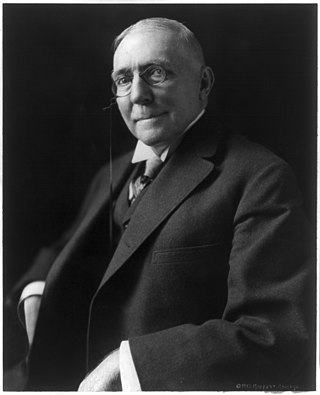
James Whitcomb Riley was an American writer, poet, and best-selling author. During his lifetime he was known as the "Hoosier Poet" and "Children's Poet" for his dialect works and his children's poetry. His poems tend to be humorous or sentimental. Of the approximately 1,000 poems Riley wrote, the majority are in dialect. His famous works include "Little Orphant Annie" and "The Raggedy Man".

Frank McKinney Hubbard, better known as Kin Hubbard, was an American cartoonist, humorist, and journalist. His most famous work was for "Abe Martin". Introduced in The Indianapolis News in December 1904, the cartoon appeared six days a week on the back page of the News for twenty-six years. The Abe Martin cartoons went into national print syndication in 1910, eventually appearing in some two hundred U.S. newspapers. Hubbard also originated and illustrated a once-a-week humor essay for the "Short Furrows" column in the Sunday edition of the News that went into syndication in 1911. The self-taught artist and writer made more than eight thousand drawings for the Indianapolis News and wrote and illustrated about a thousand essays for the "Short Furrows" column. His first published book was Collection of Indiana Lawmaker and Lobbyists (1903), followed by an annual series of Abe Martin-related books between 1906 and 1930, as well as other works such as Short Furrows (1912) and Book of Indiana (1929). Humorist Will Rogers once declared that Hubbard was "America's greatest humorist".

The Cardinal is a long distance passenger train operated by Amtrak between New York Penn Station and Chicago Union Station via Philadelphia, Washington, D.C., Charlottesville, Charleston, Huntington, Cincinnati, and Indianapolis. Along with the Capitol Limited and Lake Shore Limited, it is one of three trains linking the Northeast and Chicago. Its 1,146-mile (1,844 km) trip between New York and Chicago takes 281⁄4 hours.

James Whitcomb was a Democratic United States senator and the eighth governor of Indiana. As governor during the Mexican–American War, he oversaw the formation and deployment of the state's levies. He led the movement to replace the state constitution and played an important role at the convention to institute a law that prevented the government from taking loans in response the current fiscal crisis in Indiana. By skillfully guiding the state through its bankruptcy, Whitcomb is usually credited as being one of the most successful of Indiana's governors. He was elected to the United States Senate after his term as governor but died of kidney disease only three years later.

63rd Street station is a commuter rail station within the city of Chicago that serves the Metra Electric Line north to Millennium Station and south to University Park, Blue Island, and the Chicago neighborhood of South Chicago and the South Shore Line to Gary and South Bend, Indiana. Most South Shore Line trains do not stop at this station, except for one inbound train during the AM rush and two outbound trains during the PM rush on weekdays. As of 2018, the station is the 169th busiest of Metra's 236 non-downtown stations, with an average of 167 weekday boardings.
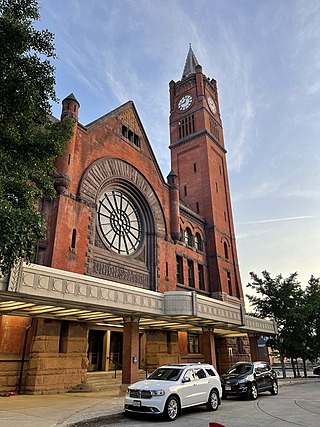
The Indianapolis Union Station is an intercity train station in the Wholesale District of Indianapolis, Indiana. The terminal is served by Amtrak's Cardinal line, passing through Indianapolis three times weekly.

The origins of the Rambo apple cultivar are unknown. It may date back to the American colony of New Sweden, when in 1637 Peter Gunnarsson Rambo, a Swedish immigrant, arrived on the Kalmar Nyckel. Swedish natural historian Pehr Kalm, who wrote Travels in North America, 1747–51, took notes of his interview with Mr. Peter Rambo, grandson of Peter Gunnarsson Rambo, recording that the ″original Peter Rambo had brought apple seeds and several other tree and garden seeds with him in a box.″ The first Rambo apple tree was very likely grown from one of these seeds. There is no certainty, however, since the earliest documented mention of the apple variety's origin occurs in William Coxe's A View of the Cultivation of Fruit Trees, and the Management of Orchards and Cider, published in 1817. Coxe wrote only that the Rambo was much cultivated in Delaware, Pennsylvania, and New Jersey and took "its name from the families by whom it was introduced into notice."

The Riley Birthplace and Museum, one of two homes called the James Whitcomb Riley House on the National Register of Historic Places, is located at 250 West Main Street in Greenfield, Indiana, twenty miles (32 km) east of downtown Indianapolis.

"Little Orphant Annie" is an 1885 poem written by James Whitcomb Riley and published by the Bowen-Merrill Company. First titled "The Elf Child", the name was changed by Riley to "Little Orphant Allie" at its third printing; however, a typesetting error during printing renamed the poem to its current form. Known as the "Hoosier poet", Riley wrote the rhymes in 19th-century Hoosier dialect. As one of his most well known poems, it served as the inspiration for the comic strip Little Orphan Annie which itself inspired a Broadway musical, several films, and many radio and television programs.
Pickard is an unincorporated community in Sugar Creek Township, Clinton County, Indiana. The community is named for Jacob Pickard who operated a sawmill at the site.
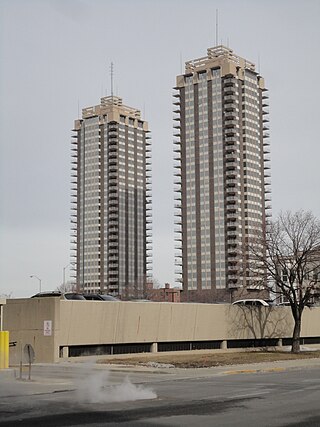
Riley Towers are three residential high-rise apartment buildings in downtown Indianapolis, Indiana, United States. Riley Towers were conceived as part of an expansive urban renewal project known as Project H. The complex was constructed between 1962 and 1963. Towers I and II have 30 floors and Tower III has 16 floors. Riley Towers I and II are the tallest residential buildings in the state of Indiana. The towers are distinctive for their cantilevered corner balconies.
Numerous narratives and folk beliefs make up the ghostlore of Indiana, a U.S. state in the Midwest, and there are many locations that are considered to be haunted by locals. Some of the hauntings are celebrated in festivals, and most have some history behind them.
The Indianapolis Journal was a newspaper published in Indianapolis, Indiana, during the nineteenth and early twentieth centuries. The paper published daily editions every evening except on Sundays, when it published a morning edition.
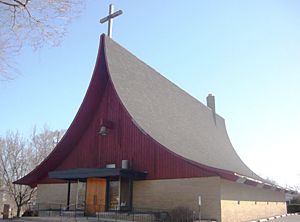
Tolleston is a neighborhood and former town in west-central Gary, Indiana. It is situated south of Ambridge, west of Midtown, east of Westside and north of Black Oak. Tolleston is the site of two large city parks, a historic cemetery, and the oldest church north of the Little Calumet River. The neighborhood's borders are defined by the Norfolk Southern tracks on the north, Grant Street on the east, 25th Avenue on the south, and Clark Road on the west. As of 2000, Tolleston had a population of 14,289, and was 97.5% African-American.

The Bethel A.M.E. Church, known in its early years as Indianapolis Station or the Vermont Street Church, is a historic African Methodist Episcopal Church in Indianapolis, Indiana. Organized in 1836, it is the city's oldest African-American congregation. The three-story church on West Vermont Street dates to 1869 and was added to the National Register in 1991. The surrounding neighborhood, once the heart of downtown Indianapolis's African American community, significantly changed with post-World War II urban development that included new hotels, apartments, office space, museums, and the Indiana University–Purdue University at Indianapolis campus. In 2016 the congregation sold their deteriorating church, which will be used in a future commercial development. The congregation built a new worship center at 6417 Zionsville Road in Pike Township, Marion County, Indiana.
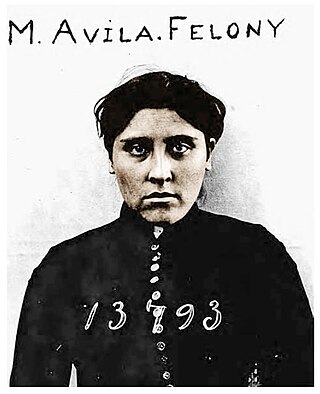
Modesta Avila was a Californio ranchera and protester, best known for being the first convicted felon and first state prisoner in Orange County, California. Avila had only received a minor warning in 1889 for placing an obstruction on the tracks to protest against the Santa Fe Railroad being built through her property without adequate compensation, but she continued to taunt the authorities, and was eventually arrested four months later.

Catlettsburg is a former Chesapeake and Ohio Railroad station located in downtown Catlettsburg, Kentucky. Opened between 1897 and 1890 to replace an older wooden station, it served trains until 1958. Amtrak trains began stopping at Tri-State Station some 1.5 miles (2.4 km) to the north in 1975; it was renamed Catlettsburg around 1988. Amtrak service was moved from Catlettsburg to Ashland in 1998. The C&O station was refurbished from 2004 to 2006 and added to the National Register of Historic Places in 2012.
Cottonville is an unincorporated community in Jackson County, Iowa, United States.

Cincinnati River Road station was an Amtrak intercity rail station located south of River Road west of downtown Cincinnati, Ohio. It opened in October 1972 to replace the underused Cincinnati Union Terminal, and closed in July 1991 when Amtrak moved service back to the restored Union Terminal.

















